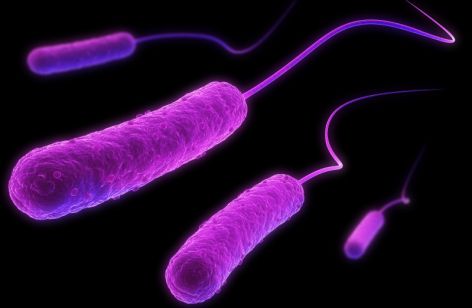Darwin described evidence that could “break down” his theory of evolution. Do modern instruments show an irreducible complexity that reveals a Creator?

The biochemistry of vision is irreducibly complex. It does not function at all unless every part is present.
In “Intelligent Design: Can Science Answer the Basic Question, Does God Exist?” we looked at a small sample of the incredible complexity and precision that exists in the universe, our solar system and the earth that, against all odds, makes life on this earth possible.
Charles Darwin looked at living creatures on this earth, including humans, when developing the theory of evolution. Yet some of what he noted in the human body perplexed him, admittedly challenging his underlying assumptions.
The problem of evil bothered Darwin
Darwin, influenced by the death of his daughter, was bothered by the problem of evil in the world. He was concerned about the “natural evils” that are independent of human free will, such as disease, predation and natural disasters. If God is all-good and all-powerful, why did He create a world with such evils? (For a study of these important questions, see our article “The Problem of Evil” and related articles.)
Darwin was deeply troubled by this question. In a letter to botanist Asa Gray in 1860 he wrote: “There seems to me too much misery in the world. I cannot persuade myself that a beneficent and omnipotent God would have designedly created the Ichneumonidae [parasitic wasps] with the express intention of their feeding within the living bodies of Caterpillars, or that a cat should play with mice. Not believing this, I see no necessity in the belief that the eye was expressly designed” (Francis Darwin, ed., The Life and Letters of Charles Darwin, 1887, vol. 2, p. 312).
According to biophysicist Cornelius G. Hunter, it was partly this concern that motivated Darwin to formulate his theory of natural selection, which by leaving the details to chance “absolved God of responsibility for nature’s iniquity” (C.G. Hunter, Darwin’s God: Evolution and the Problem of Evil, 2001, pp. 140-141).
Many evolutionists, in their attempts to support the theory, have continued the tradition of Darwin by using the idea of blind chance when they can find no other physical explanation to explain specific phenomena. But can blind chance explain irreducible complexity?
What Darwin couldn’t see
Research on the human body since Darwin’s time has been able to demonstrate incredible complexity far beyond what Darwin was able to comprehend. What made this research possible was the invention of the electron microscope, allowing scientists to view beyond the wavelengths of light. This allowed scientists to view inside protein molecules.
Later X-ray crystallography was invented, and scientists were able to view inside still smaller proteins. This technology allowed James Watson and Francis Crick to view DNA.
The current tool is called nuclear magnetic resonance, or NMR, which allows scientists to view even smaller proteins.
The “black box” of the cell has been opened; and although cells during Darwin’s day seemed very simple, today’s research shows an incredibly small, complex world that must be explained. If one were to consider the human body to be a machine, it far exceeds the complexity of any robot built today.
In The Origin of Species, Charles Darwin wrote: “If it could be demonstrated that any complex organ existed, which could not possibly have been formed by numerous, successive, slight modifications, my theory would absolutely break down” (1860, p. 189).
In his 1996 book Darwin’s Black Box, biochemist Michael J. Behe wrote: “What type of biological system could not be formed by ‘numerous successive, slight modifications’? Well, for starters, a system that is irreducibly complex. By irreducibly complex I mean a single system composed of several well-matched interacting parts that contribute to the basic function, wherein the removal of any one of the parts causes the system to effectively cease functioning” (p. 39).
Behe described several features of living cells and systems—features unknown to Darwin—that he considered to be irreducibly complex. These include the light-sensing mechanism in eyes, the human blood-clotting system and the bacterial flagellum.
Behe described several features of living cells and systems—features unknown to Darwin—that he considered to be irreducibly complex. These include the light-sensing mechanism in eyes, the human blood-clotting system and the bacterial flagellum.
The irreducible biochemistry of vision
The first example offered of irreducible complexity is the biochemistry of vision. When light strikes a photosensitive cell in an animal eye, it is absorbed by a molecule that alters an attached protein, which then initiates what biochemists call a “cascade”—a precisely integrated series of molecular reactions—that in this case causes a nerve impulse to be transmitted to the brain. The result, as interpreted by the brain, is vision.
If any molecule in the cascade is missing or defective, no nerve impulse is transmitted; the person is blind. Since the light-sensing mechanism does not function at all unless every part is present, it is irreducibly complex (Behe, pp. 18-21).
Darwin didn’t understand the chemistry of the eye. In his theory he proposed the evolution of the eye from simple to complex. He started with a simple patch of photo receptors in a jellyfish, a cupped eye found in limpets and an eye with a lens from a marine snail. He reasoned that the modern human eye evolved gradually from a simple structure, as found in the jellyfish, to increasingly complex structures, as found in marine limpets and marine snails, to the complex camera eye found in humans.
Darwin’s theory would require that each small change give survival benefits to the mutated creature. However, the biochemistry of vision shows that all the irreducibly complex parts of human vision must have developed at once to have any survival benefit.
The irreducible complexity of blood clotting
A second example of irreducible complexity is the human blood-clotting cascade. When a container of a liquid springs a leak, the fluid drains out. The rate of flow depends on the thickness of the liquid, but it will eventually come out.
When a person suffers a cut, however, it normally only bleeds for a short time before a blood clot stops it. The blood clot eventually hardens, forms a scab and heals over.
The blood-clotting cascade that leads to this blood clot consists of more than a dozen protein molecules that must interact sequentially with each other to produce a clot only at the right time and place. Each protein is extremely complex in its own right, but it is the cascade that Behe identified as irreducibly complex, because all of the molecules must be present for the system to work. If even one is missing (as in the case of hemophilia), the system fails. Thus it is irreducibly complex (Behe, pp. 78-88).
The irreducible complexity of the bacterial flagellum
A third example of irreducible complexity is the “motor” of the bacterial flagellum. This is like a tail sticking out of a bacterium that allows it to move. It’s a long, hairlike external filament embedded in the cell membrane.
The amazing bacterial flagellum is also irreducibly complex.
At the base of each flagellum is a proton-driven motor that can turn thousands of times a minute and reverse direction in a quarter turn. The motor’s drive shaft is attached to a rotor that turns within a stator, and the entire assembly is anchored in the cell wall by various bushings. The flagellum itself is attached to the drive shaft by a hook that functions as a universal joint so the flagellum can twist as it turns.
Researchers have identified several dozen proteins required for assembly and operation of the flagellum and its motor. The flagellum is composed of at least three parts—a paddle, a rotor and a motor. Remove anyone of them, and the apparatus stops working. See more about this in our article “Bacterial Flagellum: Evidence for a Creator.”
Like the light-sensing mechanism and the blood-clotting cascade, Behe considers the bacterial flagellum to be irreducibly complex.
Behe wrote: “The conclusion of intelligent design flows naturally from the data itself—not from sacred books or sectarian beliefs. Inferring that biochemical systems were designed by an intelligent agent is a humdrum process that requires no new principles of logic or science. It comes simply from the hard work that biochemistry has done over the past forty years, combined with consideration of the way in which we reach conclusions of design every day” (p. 193).
Looking at the evidence of irreducible complexity
Some evolutionists admit that the interdependent complexity they see on earth and in all life’s systems gives the impression of “apparent design,” but they dismiss it as “apparent” design. However, if something gives a very strong appearance of design, then it probably was designed by a designer.
But instead of admitting to a designer, some evolutionists use terms like “a blind watchmaker” to describe the process of evolution. Essentially that is saying the incredible complexity and fine tuning that we see in the universe, on the earth and in our human bodies, appeared by pure chance and is essentially unintelligent design.
No one would conclude that a lunar lander came together by blind chance.
If someone were to land on the moon at the same location as the original Apollo 11, that individual would see the descent stage from the lunar lander. No individual would ever conclude that the descent stage that is still sitting on the moon came together as a result of blind chance. He would know that someone designed it. It is there because of intelligent design by engineers on the earth.
Our human bodies are much more complex than the descent stage of the Apollo 11 lunar lander.
When studying evolution and intelligent design, you need to honestly look at the evidence. Is the “apparent design” in the universe, the earth and all the creatures found on it the result of blind chance or is it genuine design and the result of an intelligent designer?
Was it pure chance or God who was the designer of the human body? Scripture says it was God: “The hearing ear and the seeing eye, the LORD has made them both” (Proverbs 20:12).
If you want to learn more about intelligent design, evolution vs. creationism and what the Bible has to say on the subject, read the other articles in this section about “Is There a God?”




